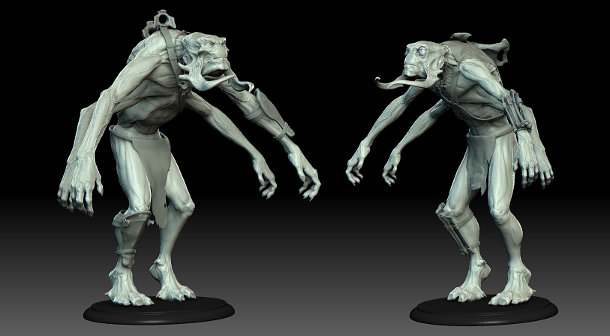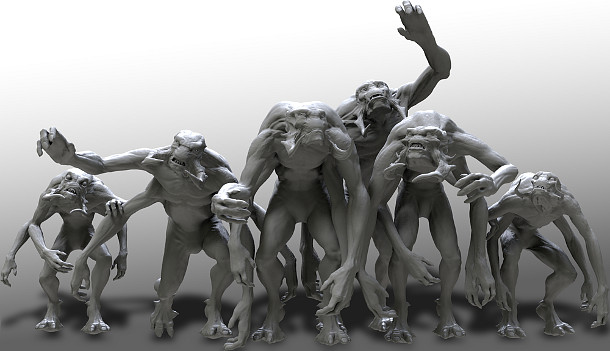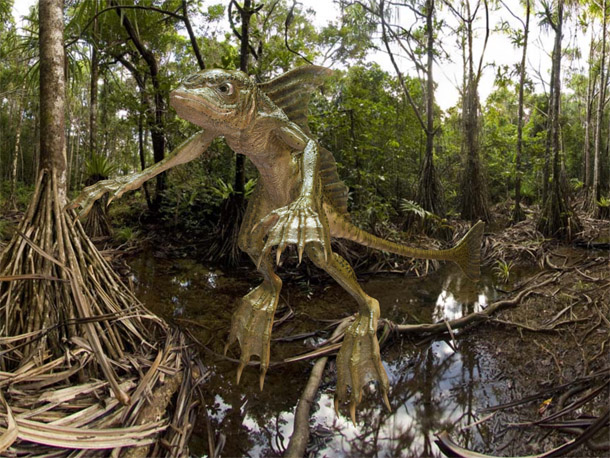Meet CG Channel’s new art contest judges
Art contests have been a key part of CG Channel from the very beginning, so it’s always a pleasure to know that they are being judged by the best in the business. We spoke to our two latest moderators about why they feel challenges like this are important for young artists, and what qualities they will be looking for in winning entries.
 Kevin Hudson, Digital Sculpting
Kevin Hudson, Digital Sculpting
Kevin worked at Sony Pictures Imageworks for 14 years on groundbreaking films such as Stuart Little and The Polar Express. He recently joined Double Negative in London as Lead/Senior Modeler, working on John Carter and The Dark Knight Rises, and now on Les Misérables, a film adaptation of the stage musical. Outside his day job, he takes on creature gigs for small movies on the SyFy channel. ?I just finished building a creature in my small apartment for Attack of the 50ft Cheerleader,? he says. ?What can I say? I love this stuff.?
Martin studied at Loyola Marymount University and UC Davis. Originally from a live-action background, he contributed lighting and miniature effects to movies including Deep Rising, Con Air, Flubber and Armageddon. Having worked as a compositor at two now sadly defunct studios, The Orphanage and Café FX, he became a Visual Effects Supervisor and Senior Art Director. He is currently a compositor at Whiskytree and senior compositor at Pixomondo, and was recently Lead Compositor on The Amazing Spider-Man.

A production maquette for the Warhoons in John Carter. Producing fully refined work like this is vital for success as a digital sculptor in today’s increasingly competitive job market, says Double Negative’s Kevin Hudson.
CG Channel: On top of your full-time jobs, you’re both instructors for the Gnomon School of Visual Effects. What made you volunteer to add to that workload by moderating these contests?
Martin Hall: I feel it’s important to give back to the FX community. Plus, I like working with new people as they are coming up. Education is a recharge from the rigors of production.
Kevin Hudson: I’m a classic overachiever, which is part of what it takes to survive in this crazy field. I got involved with Gnomon when it was just getting started, and I’ve been a part of it ever since, but I’ve never been involved with the challenges on CG Channel, so this was a chance to do something different and fun. I love working with people, and I love creating monsters!
CGC: Why are contests like this important for the CG community?
KH: We all got into this business because we love this type of stuff. I think, ultimately, I’m a hobbyist, whose hobby and passion became a career. Even if I weren’t doing this for a job, I would continue to build monsters on the side, and I bet there are a lot of other people out there who are doing the same.
CGC: And, of course, the process of preparing work for a contest is similar to preparing it for a demo reel. As a matter of interest, how many reels do you look at in a typical week?
MH: Between work and school? About 10 each week.
KH: I see around a dozen or so a month – most are from students who are looking to break into the business. I think the biggest challenge facing students is building up a quantity of work. It used to be that if you could do a couple quick models, people would look at you. Now, they want to see more refined work.
These are very challenging times. As more and more of this work goes global, you are competing against people from all over the planet, so the work you produce needs not only to be top notch, but eye-catching.
A breakdown of a shot from Grimm. Morphing effects are becoming common in VFX, says Martin Hall.
CGC: The theme of the first visual effects contest is metmorphosis. Why did you pick that topic, Martin?
MH: The morph or transformation is utilized more and more in Hollywood features. Shapeshifting is a broad concept that is seeing a lot of play currently with characters like The Hulk or TV beasties on Grimm – and then you’ve got evolution, or rapid aging. Even on a simple technical level, it’s important for FX artists to think out these kinds of effects.
CGC: What’s interesting about those kinds of shots is that they could be tackled in so many different ways, from full 3D to image morphing. Is finding the best approach going to become a key part of the contests?
MH: Yes, forethought is key. For example, if the solution you’ve chosen is strictly a 2D morph, how do you work with the talent to choreograph the before-to-after performance placement? If it’s 2D to 3D, how do you object track the face best? And if it’s 3D to 3D, how will shapes need to be built and pre-rigged for the event?
CGC: Kevin, your first theme for the sculpting contests is ‘Anatomy run Amok‘. What’s that all about?
KH: It’s a bit of an homage to the craziness we had on John Carter with creating multilimbed characters. The challenge here is to create multilimbed anatomical creations that are believable. Not necessary accurate, but believable from a storytelling perspective.
CGC: So those are both situations an artist could expect to meet in production today. What qualities will you be looking for in the entries?
KH: I’ll be looking at the character to see it I ‘buy’ it. And whether I find it ‘appealing’. Notice the word isn’t ‘attractive’. Something can be appealing and interesting and not be attractive: it just needs to be stimulating, and make me want to see more of it.
MH: Strength of concept, efficiency of delivery, and accuracy of execution.
And since I’m from a compositing background, a fully CG comp should also be well balanced and well presented. Compositing can make or break a shot. It can even save less than ideal elements.

Present your work in greyscale initially for the sculpting contests. Color is fine later, but form is key.
CGC: How would you like to see entries presented?
KH: This is a sculpting challenge, so I won’t be looking at topology: just the concept. The sculpt should be grey shaded initially: if people want to put color on later, that will be fine too, but ultimately, I will be looking at the sculpting over everything else.
MH: I’m open to anything. Sell your work like the Academy is voting on it! Breakdowns are extremely useful in showing your progress or how difficult it was to get from A to B, and there should be at least a written or verbal description of the project.
CGC: How important is it to be original? Are you looking for something you’ve never seen before – or something that could slot easily into a real production?
KH: I love seeing something outrageous. Much of my day-to-day work tends to be fairly conservative, so I like stretching that side of my artistic spirit. I’d encourage people to go BIG, and then tone back if needed. If you don’t go too far, you won’t learn how far you can go.
MH: I’d think more in terms of actual jobs. I like new, different or innovative, but it is important for young talent to show potential employers that you can deliver something similar to what clients are consistently asking for.

How far you should stray from actual production work depends on the contest. Kevin Hudson likes to see more outrageous ideas in the sculpting contests; for VFX, Martin Hall likes work that could be delivered to real clients.
CGC: What about things to avoid? What mistakes do novice artists commonly make in situations like this?
KH: Poor anatomy: not getting the muscular feeling ‘right’. Or getting the proportions wrong: you can exaggerate a character to make it feel disproportionate, but you have to do so in a believable way. And using inappropriate amounts of detail. Too little, and the character feels unrefined. Too much, and it spoils a good silhouette.
MH: Overextending themselves. Keep it simple, keep it awesome!
CGC: Are there any complete turn-offs? What makes you think: ‘Ugh. No way’?
MH: Unmotivated lens flares! That, and using commonly known demo materials. This should be the expression of your own unique artistic vision.
KH: Boring unrefined sculpts presented as final turntables. There’s nothing wrong with roughing something in, and I can tell whether a sculpt is working in a rough before it is detailed.
CGC: Let’s end with some general advice. What tips would you give an aspiring artist?
KH: Take comparative anatomy classes. Observe animals to build that subconscious knowledge. And don’t just trust your memory. I remember Stan Winston looking at people’s work, and he would always want to refresh his mind in regards to the reference material. Surround your workstation with reference to spawn ideas, to check your anatomy, and to refer to details. Oh, and practice, practice, practice.
Contest links
Visit the Digital Sculpting contest forum
Visit the Visual Effects contest forum
About Kevin Hudson
Buy training DVDs from Kevin Hudson in the Gnomon Workshop online store
About Martin Hall
Read Martin Hall’s profile on the Gnomon School of Visual Effects website



